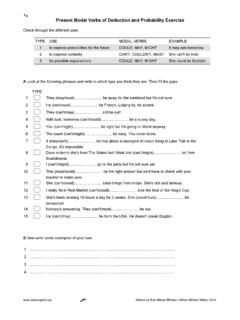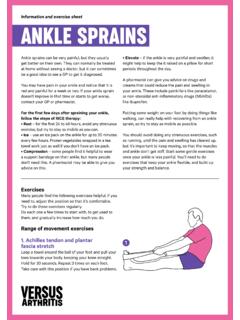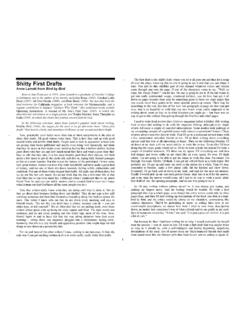Transcription of EXERCISE FOR PARKINSON’S - Brian Grant Foundation
1 EXERCISE FOR PARKINSON SRECOMMENDATIONS FOR MANAGING SYMPTOMSINSIDE THIS GUIDEEXERCISE FOR PARKINSON S OVERVIEW 3 RECOMMENDATIONS FOR EXERCISE FOR PARKINSON S 4 EXERCISE FOR PARKINSON S PRINCIPLES 5 EXERCISE FOR PARKINSON S TRAINING FOR PROFESSIONALS 8 ONLINE EXERCISE VIDEOS 8 The Brian Grant Foundation provides tools to improve the well-being of people with Parkinson s. Our programs focus on EXERCISE and nutrition to help people with Parkinson s man-age their symptoms, improve their overall health and prevent other serious illnesses. Every month, we publish an email newsletter filled with tips, expert interviews, profiles of people with Parkinson s and more. Sign up today! FOR PARKINSON S OVERVIEWE xercise is important for everyone. For people with Parkinson s, EXERCISE can improve quality of life and may help alleviate some of the most difficult motor and non-motor symptoms of the disease. Overall, EXERCISE can benefit people with Parkinson s in the following important ways:Motor Symptom Management:Research has shown that EXERCISE improves flexibility, balance, coordination, agility, gait and Symptom Management: EXERCISE may positively impact depression, anxiety, apathy, cognition and sleep Mobility Decline:Studies suggest that EXERCISE may help delay some of the common symptoms of the WORD ON PARKINSON S EXERCISE RESEARCHS tudies suggest that EXERCISE may improve how the brain uses and protects dopamine.
2 Researchers are also looking at how specific activities may help counteract some of the common symptoms of Parkinson s. For example, Tai Chi is great for improving balance whereas boxing can help with quickness and sequencing. The Brian Grant Foundation (BGF) works with researchers at the Oregon Health & Science University (OHSU) Balance Disorders Laboratory to develop evidence-based EXERCISE programs. Learn more at CONSIDERATIONSE xercise is essential for people with Parkinson s. But balance problems and other symptoms can increase the risk of falling. Here are some things to consider when engaging in an EXERCISE routine:Talk To Your Health Care ProviderMake sure you ve talked to a health care provider about your EXERCISE program, especially if you re consider-ing a new physical activity or if you re experiencing new or worsening Your MedicationsMany people with Parkinson s have on times when their medications are most effective at alleviating symp-toms.
3 Exercising during on times may be more effective, and it could reduce the risk of HydratedStaying hydrated can help with low blood pressure and dizziness, and may help reduce fall Mindful of SymptomsRemember both motor and non-motor symptoms can increase fall risk. RECOMMENDATIONS FOR EXERCISE FOR PARKINSON SRecommendations for EXERCISE Intensity and DurationRemember, any EXERCISE is better than none! Parkinson s patients enrolled in EXERCISE programs for longer than six months, regardless of intensity, have shown significant gains in function. However, greater intensity reaps greater benefits. That s why experts recommend that people with Parkinson s EXERCISE with as much intensity as is safely possible, for as long as possible. The EXERCISE sessions should be challenging, requiring focus, effort and full attention. For example, walking on a treadmill is good, but you might also try walking quickly outside with distractions, obstacles and changes in for how much and when to EXERCISE , people with Parkinson s should aim for the following: Begin training in the early stages of Parkinson s Train most days of the week for at least one hour Add mental challenges when appropriate and safe Train at higher intensity levels, meaning you can still talk while training but in short burstsRecommendations for Types of ExercisesAbove all, do what you enjoy!
4 Remember, any EXERCISE is beneficial. For people with Parkinson s, aerobic activities combined with movements that address specific symptoms can help you practice and maintain everyday motor functions that directly impact quality of life. The EXERCISE principles that follow can help you understand how physical activity can help manage the common symptoms of Parkinson FOR PARKINSON S PRINCIPLES1. Build stamina through aerobic activity. Research suggests aerobic activity supports positive changes in the brain. Aerobic activity can include high intensity walking or biking followed by other higher intensity activities, like Target specific areas for better flexibility. Rigidity along the spine causes stooped posture. Some of this rigidity comes from increased muscle tone in flexor muscles. Stretching is especially important. Focus on flexor muscles, including the chest, shoulders, abdominals, hip flexors, gluteals, hamstrings, hip adductors, and calves.
5 Activities that rotate the spine, such as kayaking, are also helpful for improving Improve and maintain flexibility with dynamic stretching. Improving flexibility can facilitate better posture and better movement. A whole body stretching rou-tine, like those done in yoga, can be particularly Strengthen extensor muscle groups to improve posture. Extensor muscles help facilitate upright posture and may reduce back pain. Practice extension exercises that strengthen the back, hips and Use BIG, full amplitude, whole-body movements. Vary patterns and sequence. Slow, small movements are a common symptom of Parkinson s. People with Parkinson s tend to think a move looks big, but it will actually be undersized. Thinking BIG helps you move BIG. Think about exaggerating your movements. Use the whole body. Move in all directions, practice turning and emphasize weight shifting6. Practice dual tasks and cognitive challenges.
6 People with Parkinson s can have difficulty performing more than one task at a time or shifting from one task to another. Practicing dual physical tasks (combining two physical activities, such as walking while doing triceps extension) can help improve this symptom. People with Parkinson s will eventually experience cognitive challenges. Adding counting or singing and other more complex cognitive challenges to a movement can help improve Practice self-initiated and self-paced movement. People with Parkinson s can also experience problems initiating movement, which can lead to abruptly halting or freezing. Keeping up a pace can also be challenging. Practice self-initiated and self-paced movements. Counting can help you keep a pace. Imagining your-self doing a movement before you perform it can help initiate Develop reciprocal motions. Uneven or non-swinging arms are common in Parkinson s and can lead to balance problems.
7 Practicing reciprocal, coordinated arm and leg movements may help address this problem. Using very light wrist weights (or holding rolled up magazines) can help increase arm swings Develop erect postural alignment. Stooped posture is a common symptom of Parkinson s that can affect balance and movement. Focus on maintaining a tall posture while doing physical activities. Think about keeping your chest lifted upwards, your shoulders back and down, the top of your head is lifted toward the ceiling, and your chin parallel to the Use strong voices. Soft and slow speech is a common symptom of Parkinson s. Practicing strong voices (speaking loudly and with intention) while exercising can help improve voice quality and Improve sensory-motor integration for balance. Sensory-motor integration refers to the communication between our senses and our muscles. In peo-ple with Parkinson s, sensory-motor integration can become impaired.
8 Balance pads, varying surfaces and inclines may help you adapt to changing conditions in the environ-ment. Reducing visual input may also help improve sensory-motor integration. Darken the room, close one eye, or put on sunglasses to reduce dependence on Practice speed and quickness. Parkinson s can cause slowness. Practicing fast movements, like footwork in boxing, can Build mind/body connections. Building mind/body connections can help promote awareness of our own movement, which can be-come impaired in Parkinson s. Mind/body connections can promote relaxation and self-awareness, both of which can positively affect anxiety and depression. Doing activities that require planning or sequencing can help build mind/body connections. Connecting breathing patterns to movement or relaxation, such as in yoga, is also Do activities that are challenging, engaging, fun, social and safe. You re more likely to stick with an activity if it s fun!
9 Make sure you also choose activities that are safe, and talk with your health care provider before engaging in new EXERCISE 1. Activities that can help manage common symptoms of Parkinson MOVEMENT PRINCIPLESSUGGESTED ACTIVITIESR igidity:Stooped posture and decreased range of motion in the neck, trunk and hips Rotating movements Reciprocal movements Rhythmic movements Extension exercises Tall, charge up posture Torso rotation exercises Pilates and yoga Chest stretches Upper back strengthening exercisesBradykinesia: Slow movementsHypokinesia: Small movements and narrow base Whole body movement Wide base of support Extensor muscle strengthening BIG and fast steps BIG arm swings Walking and agility exercises Lunging in all directions Boxing Kettlebell swingsAkinesia: Impaired sequential coordination (includes freezing) Preplanning tasks Quickly changing movements Practice moving in small spaces Understand and use external cues Adding a second task (dual tasks) Sequencing movements Walking and agility exercises Obstacle courses Quick turns in corners Lunging in all directions Boxing Kettlebell swings Impaired Sensory Integration.
10 Problems processing sensory information Practice balance on different sur-faces and environments Reducing reliance on vision and external cues Stability ball exercises BOSU ball exercises Exercises with eyes closed Exercises with head turns Stand on a foam padImpaired Balance Balance specific exercises adding visual and surface changes Weight shifting Strengthening hips and legs Stability ball exercises Lunging Tai Chi BoxingEXERCISE FOR PARKINSON S TRAINING FOR PROFESSIONALSBGF developed the EXERCISE for Parkinson s Training for Professionals program based on research from OHSU s Balance Disorders Laboratory. The training is open to EXERCISE instructors, personal trainers, physical therapists and physical therapist assistants. BGF hosts the training in select cities throughout the year. The training is also available online. Learn more at EXERCISE VIDEOSBGF has also developed a Boot Camp for Parkinson s routine that includes a variety of activities that target common symptoms of the disease.





